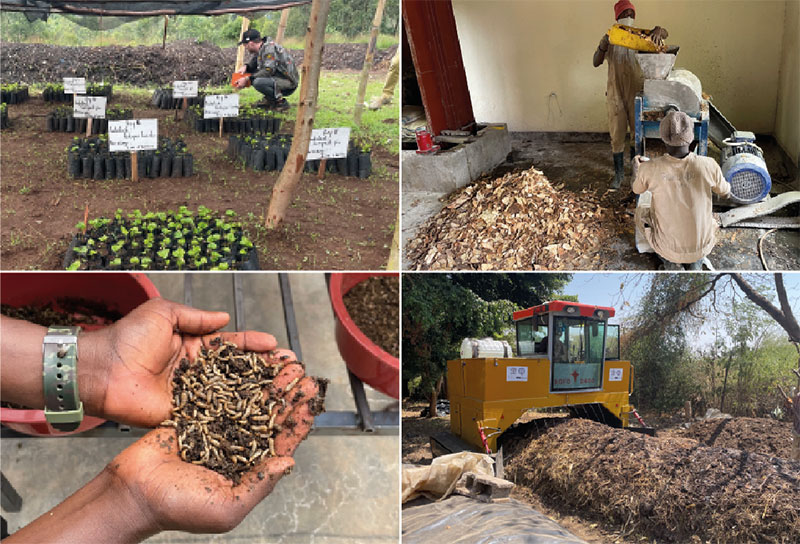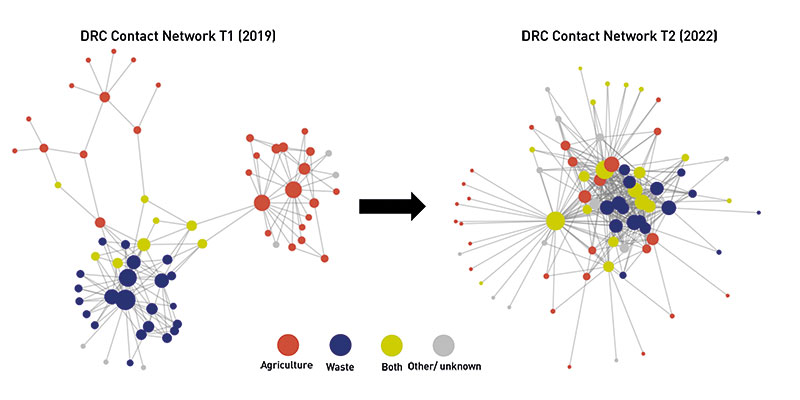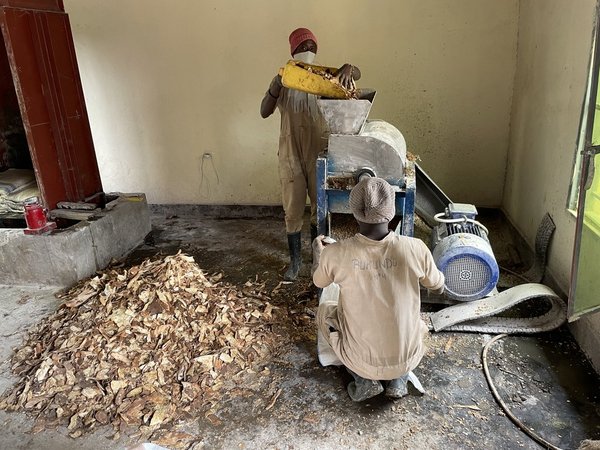 Download this article in magazine layout
Download this article in magazine layout
- Share this article
- Subscribe to our newsletter
From innovation to upscaling – circular economy in the rural-urban nexus
The RUNRES project – in full, The Rural-Urban Nexus: Establishing a Nutrient Loop to Improve City Region Food System Resilience – aims to set a key step in the transformation towards a circular and more sustainable agriculture and waste management in four city regions of sub-Saharan African countries: DR Congo, Ethiopia, Rwanda and South Africa. It is funded by the Swiss Agency for Development and Cooperation (SDC) and entails two main phases: a piloting phase (2019–23) and a scaling-up phase (2023–27). The aim of the first phase was to pilot a set of innovations and evaluate their ability to contribute to a circular economy by linking organic waste management to agriculture. For this, we took a transdisciplinary research approach, where we co-produced the different innovations with different actors: waste collectors, farmers’ cooperatives, collection and treatment companies, and regulators. This approach made it possible to co-develop innovations between science and practice that are tailored for the local context.
The innovations co-developed in phase 1 can be classified in three types: recycling organic and food waste; recycling human waste, faeces and urine; and supporting small-scale processing in relation to the flows of recycled organic waste. For each of these innovations, we ensured that they were technically feasible, that regulatory standards were met and that the output would have a meaningful impact in terms of circular economy. In addition, we evaluated how the different actors and their respective sectors integrated along with the project.
Circulating organic waste back to agriculture
By circulating organic waste back to agriculture, the innovations contribute to improved environmental and human health, one of our main objectives. For example, organic waste collected from urban centres of the city regions, transported and processed into compost, have the capacity to provide critically needed organic soil inputs for farmers in rural areas. These innovations simultaneously alleviate environmental and human health challenges in these urban centres, while also improving soil health and fertility in the adjacent agricultural zones.
In RUNRES, we used an array of technologies that we co-developed with different local actors to make them viable to the realities on the ground. The technologies that proved to be viable during our piloting phase are:

Examples of the RUNRES innovation technologies deployed in phase 1: co- and composting used for coffee plantlets (top left), cassava peels transformed into animal feed supplement (top right), black soldier flies’ larvae (bottom left) and mechanised windrow composting (bottom right). Photos: Leonhard Späth
- composting and co-composting of organic and human waste through thermophilic compost and vermi-compost production (DR Congo, Ethiopia, South Africa and Rwanda),
- rearing black soldier flies’ larvae with organic waste to produce animal feed (Rwanda),
- treating cassava peels through fermentation (to remove aflatoxins and cyanides), drying, and grinding for animal feed supplement (Rwanda),
- deactivating pathogens in urine through long-term storage for urine-derived fertiliser (Rwanda and DR Congo).
In addition, we supported small-scale food production, for instance through producing banana flour as a substitute for cereal-based flour, also adapted as baby-food (Ethiopia). Piloting these innovations enabled us to see what bottlenecks exist to their application at a larger scale, given the local context of the four participating countries.
Ensuring quality standards
The use of organic and human waste by farmers poses a number of risks due to possible pathogen and pollutant accumulation in the products. Therefore, we set up a quality assurance programme aiming to measure the following parameters to guarantee the quality of the products: the agronomic parameters, for instance nitrogen, phosphorus, potassium and carbon, the level of pathogens, for example Escherichia coli or Helminths’ eggs, and the amount of heavy metals, for instance lead or cadmium. Overall, it has become apparent that soil inputs produced through the project have agronomic parameters similar to compost which can be found on the market. We could also show that the processes set in place deactivated harmful pathogens. The remaining challenge is the level of some heavy metals, which exceeded the norms in some places, although these cases were rather exceptional.
Settings for upscaling
The innovations piloted during the first project phase were, inter alia, selected according to their potential viability for scaling. The different innovations will have three different settings to allow an upscaling in capacity and space:
Upscaling: this setting will be the next step for existing consortia which we piloted in Phase 1, and which are already working on RUNRES innovations. In this setting, the existing innovations will continue to grow, aiming to reach a larger output with a strongly decreased intensity of financial contribution through the project.
Replicating: In this setting, most of the innovations will be replicated through other transdisciplinary consortia, i.e. implemented in other places by other actors. The development of these innovations is to be directly supported through technical backup and co-financing by the RUNRES core team. However, the project’s financial contribution for this setting will be significantly lower per unit of output compared to Phase 1, since the expertise has already been developed through the piloting.
Supporting: This last setting will take place in the form of indirect support to implement RUNRES innovations by other actors who have their own financial means for implementation. The actors we target are already active in organic waste recovery, but may be in a different area of the countries we focus on. The project will not directly financially support these innovations but will provide indirect support by making available its acquired knowledge in the successful implementation of the innovations.
The different innovation settings of the second phase will be deployed timely over four years. While the initial focus is to be on upscaling the innovations from Phase 1 that have been evaluated as suitable for upscaling, we aim in parallel at replicating these innovations in different places with new actors. This will take place through public-private partnerships and through the co-development of business plans with the new actors, with the aim of leveraging financial resources from existing business development institutions. While some innovations are to be upscaled through the private sector, others will require committed support from the public sector, for instance for organic-waste sorting and collection at a household level. Finally, later in time, we aim at supporting any actors interested in recovering organic waste through the quality assurance capacity developed along with the project. In this way, we will be able to first scale up and then scale out to make a substantial contribution to sustainability through a large deployment of circular economy solutions.
Creating capacity by fostering social networks
A transdisciplinary approach often involves collaboration among researchers from different disciplines, as well as practitioners, like farmers, waste collectors and waste transformers. To observe the evolution of the collaboration between different actors, we used Social Network Analysis (SNA), which is based on the concept that social relationships are not isolated entities but are part of a larger network of connections and interactions. An example of how collaborations evolved over time in the RUNRES network of DRC from 2019 to 2022 is shown in the Figure. The nodes represent individuals who are to some degree involved in the project or its topics. The networks are contact networks; hence, if two nodes are connected with an edge, they share information related to RUNRES topics. The colour of the nodes indicates whether the respective individual is part of the agriculture sector (red), the waste sector (blue) or both sectors (grey).
The size of the nodes represents the degree of centrality: a bigger node means that this individual has more connections in the network. For the DRC network, we observe substantial changes between the periods 2019 (T1) and 2002 (T2). While for T1 the agriculture and the waste sectors only have some connections, the two sectors are now integrated. The new linkages show exchange of knowledge and dialogue, and therefore allow for learning –
a prerequisite for transformation.
Leonhard Späth is a social scientist at the Sustainable Agroecosystems’ Group (SAE) and Transdisciplinarity Lab (TdLab) at ETH Zurich, Switzerland. His focus is the integration of different stakeholders’ perspectives to co-design projects.
Sharon Migeri is an agricultural scientist at the Sustainable Agroecosystems’ Group (SAE) at ETH Zurich. Her role is to ensure quality of products produced through RUNRES innovations.
Johan Six is a Professor at ETH Zurich and leads the SAE group. His research ranges from basic soil science to applied food systems research.
Contact: leonhard.spaeth@usys.ethz.ch
The RUNRES team are: Abayneh Feyso, Alfred Odindo, Behailu Merdekios, Benjamin Wilde, Emmanuel Rukundo, Kinfe Kassa, Kokou Kintche, Matieyedou Konlambigue, Mélanie Surchat, Moustapha Byamungu, Ndoda Zondo, Pius Krütli, Rea Pärli, Samuel Getahun, Simon Gwara, Speciose Kantengwa and William Musazura.





Add a comment
Be the First to Comment